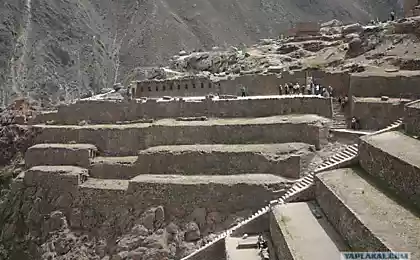853
Man-made flood
In May 1943, the British had a unique air raids on Germany. They are accurate bombings managed to destroy several German dams on reservoirs. The result was flooded a significant part of the Ruhr industrial region.
After the start of World War II, the famous English designer and inventor Barnes Wallis suggested an unconventional way to undermine the economic power of the Germans. To do this, should air strikes to destroy the dam and dam reservoirs in the industrial Ruhr region, are released to the water flooded to cities and factories, and at the same time would have stopped the work of a number of hydroelectric power plants. To do this, Wallace chose to hydro lakes Myung, Eder and Zorpe. However, conventional bombs could not inflict lasting concrete structures of significant damage.
We needed a fundamentally new solutions. He found the drawings of those built in 1911 - 1914 years. dams and came to the conclusion that their vulnerability is in the center of the base, from the reservoir. There is to be reset Super bomb weighing 10 tons to fall after she went to the ground and the explosion would have caused the displacement and the destruction of the foundation, while construction will not stand the pressure of pent them water. The military are interested in this, we conducted a study and decided that should be done to undermine the special mine weighing 5 tons in May, when lakes and reservoirs are filled to the maximum.
In the garden of his home in Wallis Effindgeme he dug a pond, and on it built a dam in the layout Mёne a scale of 1:50 and undermined his two charges, laid the basis for the dam. Already the first explosion led to cracks, the second to create a high hydraulic pressure and the dam destroyed. The following experiment was conducted in the presence of the BBC in Wales at the dam, built on a small lake that was five times smaller dam Mёne. After two explosions occurred in her hole, into which the water flowed. Now convinced of the effectiveness of the military offers an inventor and started its implementation.
Mina is designed as a drum, and a plane equipped with a rotating device, it slows down the movement of the water. To prevent a premature explosion on impact with the water, the prototype of mines dropped from 4-engine bomber "Wellington" walking at low altitude, there is cameramen filmed and the film was shown to the Prime Minister Winston Churchill, who had authorized the operation.
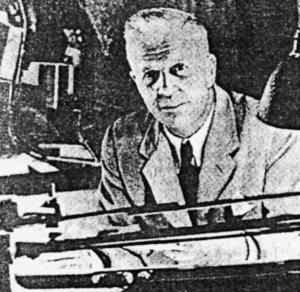
In February 1943, they formed a squadron of bombers "Lancaster", which was appointed commander Colonel Guy Gibson. It was based at the airfield in Scampton. Officially, there were engaged in ordinary crew training, but on how they spent their time in fact, did not even know some of the staff officers. But the Germans are not alerted flights to the Ruhr area reconnaissance plane, watch for changes in water level in reservoirs and lakes and antiaircraft positions
Meanwhile, back in the 1939 Lord Mayor of the Ruhr Dilgart asked Wehrmacht command to strengthen the air defense dams and repeatedly such applications, indicating that the enemy will try to strike a blow for him was in May. A crew of "Lancaster" intensively trained, mastered flights to ultra-low altitudes than irritated locals. Moonlit nights simulated day, closing the lights yellow plexiglass booths and giving pilots blue glasses.
English specially modified bomber "Lancaster" V.MKIII (1943): "dry" weight - 16, 8 tons, takeoff - 28 t, speed - 432 km / h, armament: eight guns caliber 7, 7 mm, 6, 5 tons bombs, power 4-propulsion power plant - 6500 hp, ceiling - 6600 m, flight range - up to 2800 km, the length - 21 meters, wingspan - 31, 1 m, the wing area - 119, 5 m2, the crew - seven people. Built in 7377 this type of aircraft of various modifications.
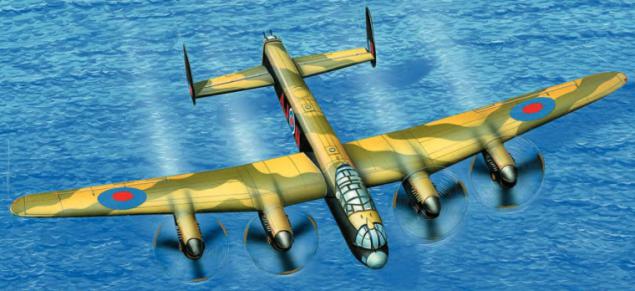
Before resetting the charge should go to the target, hold the 30-ton bomber at 18 m from the surface of the water. And it's not accurate altimeter, and even in the dark, and perhaps in the fog. We had to improvise - in the nose and tail of the aircraft installed converts each other and down spotlights, whose rays converge in the 18 m under the belly of the aircraft. However, their light unmasked machines and facilitates the work of the German anti-aircraft gunners.
But how to please a mine in the center of the dam? They remembered that they were towers. Plywood contrived triangles eyepiece at one end and at the other pins. If the pilot looking through the eyepiece, noticed that the alignment of the tower with the pins, it should immediately dump mine. For training at the dam of an English lake built similar towers and pilots, focusing on them unloaded from above the dam layouts min.
In early May 1943, Colonel Gibson was converted to suspension impressive mines "Lancaster" on May 13, brought themselves ammunition weighing 4190 kg. Their shells high power explosives, navigators mapped the latest data on the situation in the Ruhr.
Gibson planned a raid in three waves. Sam took a lead of nine bombers in the southern objects egozamestitel Munro had sent five cars to the northern, five more highlighted in the reserve, they have to take off 2 hours after the main forces. If the latter will not be able to destroy the dam in Mёne, Eder and Zorpe, reservists will do it, and if successful, they would drop the charges on small dams in Shvelte, Ennerpe and Dimle.
On the morning of May 15, crews studied models of dams and their surrounding areas on May 16, the last time they were instructed, and 21 hours and 10 minutes over the airfield soared Red Rocket - a signal to take off the first wave of planes. Wallis was involved in the preparation of the operation, trained crews use the sighting device and now with Marshal Arthur Harris followed the raid at the main headquarters of the Command of the Royal Air Force Bomber Command.
After completing the job, the crews of the first wave were to broadcast the word "nigger" - a nickname dog Gibson. After 1 h 15 min planes approached the coast of the Netherlands and the trouble started. One machine dropped mine in the North Sea, and the other - came under fire from anti-aircraft guns, was damaged and they had to come back. The rest went to the objectives, closely hugging the ground, but because the observers of the German defense did not see and could not bring them interceptors. The shaded Germany seemed to be extinct, but the approaches to the Ruhr flak alive. Blinded by the rays of spotlights pilot of "Lancaster" lost control of the plane fell into a nosedive and crashed into the ground. Other anti-aircraft gunners shot down.
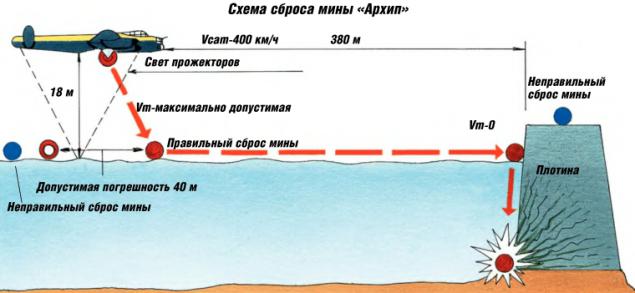
Soon the pilots saw the mist emerged from the hills and lakes of the Ruhr. When Gibson noted Myung lake and dam, then did a few laps on them, specifying landmarks and looking at a massive dam, which on his plane hit the gun. Gibson led the car to the goal, turned on the light altimeter, down to 18 meters and lay on the combat course. The bomber raced through the route of shells and bullets, it was impossible to turn off, side arrows fired back. Throwing a mine Gibson slipped between the towers, he turned around, and the British saw the shot up above the dam water column height of about 300 meters and hit her. The dam was not damaged!
After 10 minutes, she went to the second "Lancaster" - the Germans have seen perfectly illuminated "altimeter" plane, and one of them issued shells hit the wing tank. The pilot dropped the mine, but it flew over the dam and fell in front of the power station, where he worked. Pilot burning bomber tried to gain altitude, necessary for deployment of the parachute, but broke all the gas tanks ... Because of the hills emerged third "Lancaster". Gibson was attached to it, distracting the attention of anti-aircraft gunners and firing their machine guns. I dropped mine hit the target, and a plane - two shells. He survived. As the dam.
Gibson tried to cover up, and the fourth bomber, even included navigation lights. Now explosion raised column of water covered the dam, but this time she remained unharmed. After entering the fifth "Lancaster", the members of its crew are well seen as the dam began to fall apart, and through hole formed therein in the valley poured a real waterfall of 134 million tons of water moving at the speed of 200 km / h. The headquarters of the matter the word "nigger» ...
The water swept away houses and other buildings, rails and sleepers, carried off cars and wagons. Gibson ordered to unload the crews to return, and others led to the Eder dam. Although the night and the fog, he found her and collected bombers circled over the lake. The emergence of the British anti-aircraft guns somehow ignored.
This dam was located between two hills and hilly terrain are not allowed to go to the target at low level, so the first attempt failed sbrosku minutes left. So, the third "Lancaster" dived into the valley with the included altimeter dropped mine at high speed, that splashed down, bounced on the surface of the lake hit the dam and exploded in the moment when the plane was flying over it ...
Next pilot maneuvered delicately, just dropped the charge, but the dam and made the blow. And Gibson was the last plane. Fortunately, it turned out to be a sniper pilot - after its flyby of the explosion threw up a dam, a hole was larger than Mёne, and the consequences of artificial floods least destructive.
In the south, a group of the second wave of planes aimed at the dam Zorpe, off course, and the fire from the ground lost two cars. Couple remaining machines dropped the charges after accomplishing in her hole, and damaged a similar facility in Ennerpe. Nine survivors "Lancaster" had to leave Germany for an hour before dawn. And on the job to go 19 cars ...
Commander Bomber Harris reported to the Prime Minister Churchill on the implementation of the task. Soon spy plane was taken photographic evidence - the photographs could be seen that the water came from and Mёna Eder.
After the war, the British got hold of the German documents, from which it followed that the victims of the raid was in 125 companies, 25 bridges, flooded 8 thousand. Hectares of agricultural land, killed 6, 5 thousand. Cattle. Affected airports with aircraft is on them, and hangars, several power plants - houses and factories were left without power. Drowned in 1294 people, mostly prisoners of war, the Germans left the states, and behind the barbed wire of concentration camps.
Returning to the airfield British pilots became national heroes, 34 were awarded medals, including the "Cross for Distinguished Service" and "cross for Flight Services" and their commander Gibson became a knight of the highest Order of the British Empire, "Victoria Cross", which was established by Queen Victoria in 1856, which is celebrated only in wartime exploits.
May 27 King George VI visited the now famous department and approved its logo. It showed the destruction of dams with water gushing out of it and the motto "After us the deluge!»
Thus ended a unique operation, conducted by the British airmen and intelligence, as a result of which the belligerent German economy and, above all, the military, there is substantial damage. And in a manner of its implementation - creating an artificial flood, it can be rightly called the only one of its kind.
Destroyed by British pilots dam on Lake Myung
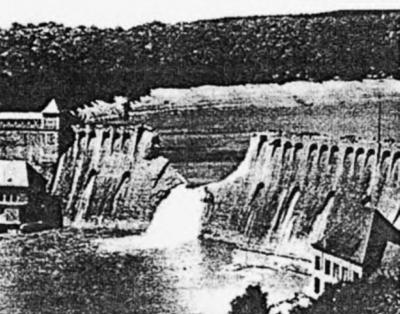
Road to the Ruhr
Reid "Lancaster" on colonel G.Gibsona German waterworks was one of the episodes air offensive against Germany. September 3, 1939, Britain and France declared war on her, and the next day on a naval base in the British bombers were Vilgelmsgafene. "The planes were on low-level flight with the" great chic "- wrote after the war Grand Admiral K.Denits - and died without achieving any significant success."
While on land languidly stretched "phony war", the British continued raids on military installations, sending them long-range bombers "Lancaster", "Halifax", "Stirling", "Bellington" and mean "Blenheim", carrying a substantial loss of fighters and anti-aircraft gunners . Therefore, in April 1940, they had to move to the action at night.
However, the "night bombardment by British aircraft have caused little damage - witness was then a correspondent in Germany from the United States U.Shirer. - Not only do they not put out of action, but did not damage the German airfields. "
In May 1940, the British pilots switched to oil refineries, railroad junctions and enterprises of the Ruhr area. Combat losses reimbursed British aircraft factories, and has not fought in the United States purchased the B-17 bomber "Fortress" B-24 "Liberator," B-25 "Mitchell" and the B-26 "Marauder".
Germany on May 15 sent 50 planes at once. British Prime Minister Winston Churchill called it "the beginning of a strategic air offensive." In October bombers ordered to perform night flights not only in plants but also in the city to calling the population discontent with the Nazi regime to suppress his will to resist Flying in poor visibility, and even at night with unimportant sighting device (deviation of bombs on targets reached up to 1 thousand m) led to the use of massive air raids, when hundreds of bombers, "unloaded on the areas." However, in this period, the British airmen had to start in the "Battle of Britain".
July 16, 1940 Adolf Hitler approved a plan for the invasion of England, "Sea Lion", and the Germans began to be preceded by its activities. In particular, 8-19 August of aircraft repeatedly attacked convoys in the English Channel and the airfields on the "island", hoping to dislodge fighters to protect them and to secure air supremacy during landings. August 19 - September 5, started to bomb London and other cities to demoralize the population. Since the British fighters acted very effectively, the Germans, like their opponents, switched to night work - recall, at least, the destruction of Coventry on November 11, which killed many residents.
The situation improved after the British attack of Germany on the Soviet Union, where the main force "Luftwaffe" was transferred to the Eastern Front and after 7 December of the same year, after the Japanese attack on Pearl Harber, after which the United States entered into World War II. Soon the American B-17 units have settled in England and started raids on military and industrial targets of the enemy.
February 14, 1942 the command of the British Bomber Command was ordered to take all necessary for "undermining the morale of the civilian population and, in particular, the industrial workers." In the same month, the commander of Bomber became A.Harris, improving its organization and tactics of the application.
March 3 235 bombers smashed the Germans worked at the plant of the company "Renault" near Paris, having lost one car, the other filled with incendiary bombs German Lubeck. In April, the aim of the pilots was the historic center of Rostock, where there were no military targets, May 30, 1942 1046 bombers attacked Cologne, the Germans shot down 40 aircraft. June 1 956 cars went to Essen (lost 31). As long as pilots in England and the United States terrorized the Germans ... German war production increased by 50% ...
In January 1943, at a conference in Casablanca attended by Winston Churchill and US President Franklin Roosevelt, we decided to precede the invasion of Europe "sequential destruction and disorganization of military, industrial and economic system of Germany and undermine the morale of the people, until a strongly weakened its ability to armed resistance. " This mission was entrusted to the bombers. Allies have agreed that US pilots will operate during the day, fighter escort, and the British at night.
In March, it began in 1944 ended in "a battle for the industrial Ruhr," a part of which was held May 16 raid "Lancaster" G.Gibsona. Before that and later the Allies bombed the starting position "V-1" and "V-2", airports, warehouses, railways and highways, ports, bases, factories, shore batteries and continued to intimidate the population, residential neighborhoods of Berlin, Hamburg, Frankfurt , Leipzig, Konigsberg and other cities. Suffice it to recall a massive bombardment of January 27, 1945 the old Dresden, which was about was to capture the Red Army. To get the Allies and Germany, in particular, Romania - US aircraft repeatedly processed Ploesti oil fields in neighboring oil refining companies, fuel depots and the city.
Massive bombing of Germany caused certain damage to her, but, as noted British military historian B. Liddell Hart, "it did not have a noticeable effect on the level of industrial production and the morale of the German people." Do not break the massive bombing and Japanese resistance - they stop the hostilities only after the defeat of the Kwantung Army by Soviet troops, after which the Emperor of Japan ordered his subjects to lay down their arms.
Source:
After the start of World War II, the famous English designer and inventor Barnes Wallis suggested an unconventional way to undermine the economic power of the Germans. To do this, should air strikes to destroy the dam and dam reservoirs in the industrial Ruhr region, are released to the water flooded to cities and factories, and at the same time would have stopped the work of a number of hydroelectric power plants. To do this, Wallace chose to hydro lakes Myung, Eder and Zorpe. However, conventional bombs could not inflict lasting concrete structures of significant damage.
We needed a fundamentally new solutions. He found the drawings of those built in 1911 - 1914 years. dams and came to the conclusion that their vulnerability is in the center of the base, from the reservoir. There is to be reset Super bomb weighing 10 tons to fall after she went to the ground and the explosion would have caused the displacement and the destruction of the foundation, while construction will not stand the pressure of pent them water. The military are interested in this, we conducted a study and decided that should be done to undermine the special mine weighing 5 tons in May, when lakes and reservoirs are filled to the maximum.
In the garden of his home in Wallis Effindgeme he dug a pond, and on it built a dam in the layout Mёne a scale of 1:50 and undermined his two charges, laid the basis for the dam. Already the first explosion led to cracks, the second to create a high hydraulic pressure and the dam destroyed. The following experiment was conducted in the presence of the BBC in Wales at the dam, built on a small lake that was five times smaller dam Mёne. After two explosions occurred in her hole, into which the water flowed. Now convinced of the effectiveness of the military offers an inventor and started its implementation.
Mina is designed as a drum, and a plane equipped with a rotating device, it slows down the movement of the water. To prevent a premature explosion on impact with the water, the prototype of mines dropped from 4-engine bomber "Wellington" walking at low altitude, there is cameramen filmed and the film was shown to the Prime Minister Winston Churchill, who had authorized the operation.

In February 1943, they formed a squadron of bombers "Lancaster", which was appointed commander Colonel Guy Gibson. It was based at the airfield in Scampton. Officially, there were engaged in ordinary crew training, but on how they spent their time in fact, did not even know some of the staff officers. But the Germans are not alerted flights to the Ruhr area reconnaissance plane, watch for changes in water level in reservoirs and lakes and antiaircraft positions
Meanwhile, back in the 1939 Lord Mayor of the Ruhr Dilgart asked Wehrmacht command to strengthen the air defense dams and repeatedly such applications, indicating that the enemy will try to strike a blow for him was in May. A crew of "Lancaster" intensively trained, mastered flights to ultra-low altitudes than irritated locals. Moonlit nights simulated day, closing the lights yellow plexiglass booths and giving pilots blue glasses.
English specially modified bomber "Lancaster" V.MKIII (1943): "dry" weight - 16, 8 tons, takeoff - 28 t, speed - 432 km / h, armament: eight guns caliber 7, 7 mm, 6, 5 tons bombs, power 4-propulsion power plant - 6500 hp, ceiling - 6600 m, flight range - up to 2800 km, the length - 21 meters, wingspan - 31, 1 m, the wing area - 119, 5 m2, the crew - seven people. Built in 7377 this type of aircraft of various modifications.

Before resetting the charge should go to the target, hold the 30-ton bomber at 18 m from the surface of the water. And it's not accurate altimeter, and even in the dark, and perhaps in the fog. We had to improvise - in the nose and tail of the aircraft installed converts each other and down spotlights, whose rays converge in the 18 m under the belly of the aircraft. However, their light unmasked machines and facilitates the work of the German anti-aircraft gunners.
But how to please a mine in the center of the dam? They remembered that they were towers. Plywood contrived triangles eyepiece at one end and at the other pins. If the pilot looking through the eyepiece, noticed that the alignment of the tower with the pins, it should immediately dump mine. For training at the dam of an English lake built similar towers and pilots, focusing on them unloaded from above the dam layouts min.
In early May 1943, Colonel Gibson was converted to suspension impressive mines "Lancaster" on May 13, brought themselves ammunition weighing 4190 kg. Their shells high power explosives, navigators mapped the latest data on the situation in the Ruhr.
Gibson planned a raid in three waves. Sam took a lead of nine bombers in the southern objects egozamestitel Munro had sent five cars to the northern, five more highlighted in the reserve, they have to take off 2 hours after the main forces. If the latter will not be able to destroy the dam in Mёne, Eder and Zorpe, reservists will do it, and if successful, they would drop the charges on small dams in Shvelte, Ennerpe and Dimle.
On the morning of May 15, crews studied models of dams and their surrounding areas on May 16, the last time they were instructed, and 21 hours and 10 minutes over the airfield soared Red Rocket - a signal to take off the first wave of planes. Wallis was involved in the preparation of the operation, trained crews use the sighting device and now with Marshal Arthur Harris followed the raid at the main headquarters of the Command of the Royal Air Force Bomber Command.
After completing the job, the crews of the first wave were to broadcast the word "nigger" - a nickname dog Gibson. After 1 h 15 min planes approached the coast of the Netherlands and the trouble started. One machine dropped mine in the North Sea, and the other - came under fire from anti-aircraft guns, was damaged and they had to come back. The rest went to the objectives, closely hugging the ground, but because the observers of the German defense did not see and could not bring them interceptors. The shaded Germany seemed to be extinct, but the approaches to the Ruhr flak alive. Blinded by the rays of spotlights pilot of "Lancaster" lost control of the plane fell into a nosedive and crashed into the ground. Other anti-aircraft gunners shot down.

Soon the pilots saw the mist emerged from the hills and lakes of the Ruhr. When Gibson noted Myung lake and dam, then did a few laps on them, specifying landmarks and looking at a massive dam, which on his plane hit the gun. Gibson led the car to the goal, turned on the light altimeter, down to 18 meters and lay on the combat course. The bomber raced through the route of shells and bullets, it was impossible to turn off, side arrows fired back. Throwing a mine Gibson slipped between the towers, he turned around, and the British saw the shot up above the dam water column height of about 300 meters and hit her. The dam was not damaged!
After 10 minutes, she went to the second "Lancaster" - the Germans have seen perfectly illuminated "altimeter" plane, and one of them issued shells hit the wing tank. The pilot dropped the mine, but it flew over the dam and fell in front of the power station, where he worked. Pilot burning bomber tried to gain altitude, necessary for deployment of the parachute, but broke all the gas tanks ... Because of the hills emerged third "Lancaster". Gibson was attached to it, distracting the attention of anti-aircraft gunners and firing their machine guns. I dropped mine hit the target, and a plane - two shells. He survived. As the dam.
Gibson tried to cover up, and the fourth bomber, even included navigation lights. Now explosion raised column of water covered the dam, but this time she remained unharmed. After entering the fifth "Lancaster", the members of its crew are well seen as the dam began to fall apart, and through hole formed therein in the valley poured a real waterfall of 134 million tons of water moving at the speed of 200 km / h. The headquarters of the matter the word "nigger» ...
The water swept away houses and other buildings, rails and sleepers, carried off cars and wagons. Gibson ordered to unload the crews to return, and others led to the Eder dam. Although the night and the fog, he found her and collected bombers circled over the lake. The emergence of the British anti-aircraft guns somehow ignored.
This dam was located between two hills and hilly terrain are not allowed to go to the target at low level, so the first attempt failed sbrosku minutes left. So, the third "Lancaster" dived into the valley with the included altimeter dropped mine at high speed, that splashed down, bounced on the surface of the lake hit the dam and exploded in the moment when the plane was flying over it ...
Next pilot maneuvered delicately, just dropped the charge, but the dam and made the blow. And Gibson was the last plane. Fortunately, it turned out to be a sniper pilot - after its flyby of the explosion threw up a dam, a hole was larger than Mёne, and the consequences of artificial floods least destructive.
In the south, a group of the second wave of planes aimed at the dam Zorpe, off course, and the fire from the ground lost two cars. Couple remaining machines dropped the charges after accomplishing in her hole, and damaged a similar facility in Ennerpe. Nine survivors "Lancaster" had to leave Germany for an hour before dawn. And on the job to go 19 cars ...
Commander Bomber Harris reported to the Prime Minister Churchill on the implementation of the task. Soon spy plane was taken photographic evidence - the photographs could be seen that the water came from and Mёna Eder.
After the war, the British got hold of the German documents, from which it followed that the victims of the raid was in 125 companies, 25 bridges, flooded 8 thousand. Hectares of agricultural land, killed 6, 5 thousand. Cattle. Affected airports with aircraft is on them, and hangars, several power plants - houses and factories were left without power. Drowned in 1294 people, mostly prisoners of war, the Germans left the states, and behind the barbed wire of concentration camps.
Returning to the airfield British pilots became national heroes, 34 were awarded medals, including the "Cross for Distinguished Service" and "cross for Flight Services" and their commander Gibson became a knight of the highest Order of the British Empire, "Victoria Cross", which was established by Queen Victoria in 1856, which is celebrated only in wartime exploits.
May 27 King George VI visited the now famous department and approved its logo. It showed the destruction of dams with water gushing out of it and the motto "After us the deluge!»
Thus ended a unique operation, conducted by the British airmen and intelligence, as a result of which the belligerent German economy and, above all, the military, there is substantial damage. And in a manner of its implementation - creating an artificial flood, it can be rightly called the only one of its kind.
Destroyed by British pilots dam on Lake Myung

Road to the Ruhr
Reid "Lancaster" on colonel G.Gibsona German waterworks was one of the episodes air offensive against Germany. September 3, 1939, Britain and France declared war on her, and the next day on a naval base in the British bombers were Vilgelmsgafene. "The planes were on low-level flight with the" great chic "- wrote after the war Grand Admiral K.Denits - and died without achieving any significant success."
While on land languidly stretched "phony war", the British continued raids on military installations, sending them long-range bombers "Lancaster", "Halifax", "Stirling", "Bellington" and mean "Blenheim", carrying a substantial loss of fighters and anti-aircraft gunners . Therefore, in April 1940, they had to move to the action at night.
However, the "night bombardment by British aircraft have caused little damage - witness was then a correspondent in Germany from the United States U.Shirer. - Not only do they not put out of action, but did not damage the German airfields. "
In May 1940, the British pilots switched to oil refineries, railroad junctions and enterprises of the Ruhr area. Combat losses reimbursed British aircraft factories, and has not fought in the United States purchased the B-17 bomber "Fortress" B-24 "Liberator," B-25 "Mitchell" and the B-26 "Marauder".
Germany on May 15 sent 50 planes at once. British Prime Minister Winston Churchill called it "the beginning of a strategic air offensive." In October bombers ordered to perform night flights not only in plants but also in the city to calling the population discontent with the Nazi regime to suppress his will to resist Flying in poor visibility, and even at night with unimportant sighting device (deviation of bombs on targets reached up to 1 thousand m) led to the use of massive air raids, when hundreds of bombers, "unloaded on the areas." However, in this period, the British airmen had to start in the "Battle of Britain".
July 16, 1940 Adolf Hitler approved a plan for the invasion of England, "Sea Lion", and the Germans began to be preceded by its activities. In particular, 8-19 August of aircraft repeatedly attacked convoys in the English Channel and the airfields on the "island", hoping to dislodge fighters to protect them and to secure air supremacy during landings. August 19 - September 5, started to bomb London and other cities to demoralize the population. Since the British fighters acted very effectively, the Germans, like their opponents, switched to night work - recall, at least, the destruction of Coventry on November 11, which killed many residents.
The situation improved after the British attack of Germany on the Soviet Union, where the main force "Luftwaffe" was transferred to the Eastern Front and after 7 December of the same year, after the Japanese attack on Pearl Harber, after which the United States entered into World War II. Soon the American B-17 units have settled in England and started raids on military and industrial targets of the enemy.
February 14, 1942 the command of the British Bomber Command was ordered to take all necessary for "undermining the morale of the civilian population and, in particular, the industrial workers." In the same month, the commander of Bomber became A.Harris, improving its organization and tactics of the application.
March 3 235 bombers smashed the Germans worked at the plant of the company "Renault" near Paris, having lost one car, the other filled with incendiary bombs German Lubeck. In April, the aim of the pilots was the historic center of Rostock, where there were no military targets, May 30, 1942 1046 bombers attacked Cologne, the Germans shot down 40 aircraft. June 1 956 cars went to Essen (lost 31). As long as pilots in England and the United States terrorized the Germans ... German war production increased by 50% ...
In January 1943, at a conference in Casablanca attended by Winston Churchill and US President Franklin Roosevelt, we decided to precede the invasion of Europe "sequential destruction and disorganization of military, industrial and economic system of Germany and undermine the morale of the people, until a strongly weakened its ability to armed resistance. " This mission was entrusted to the bombers. Allies have agreed that US pilots will operate during the day, fighter escort, and the British at night.
In March, it began in 1944 ended in "a battle for the industrial Ruhr," a part of which was held May 16 raid "Lancaster" G.Gibsona. Before that and later the Allies bombed the starting position "V-1" and "V-2", airports, warehouses, railways and highways, ports, bases, factories, shore batteries and continued to intimidate the population, residential neighborhoods of Berlin, Hamburg, Frankfurt , Leipzig, Konigsberg and other cities. Suffice it to recall a massive bombardment of January 27, 1945 the old Dresden, which was about was to capture the Red Army. To get the Allies and Germany, in particular, Romania - US aircraft repeatedly processed Ploesti oil fields in neighboring oil refining companies, fuel depots and the city.
Massive bombing of Germany caused certain damage to her, but, as noted British military historian B. Liddell Hart, "it did not have a noticeable effect on the level of industrial production and the morale of the German people." Do not break the massive bombing and Japanese resistance - they stop the hostilities only after the defeat of the Kwantung Army by Soviet troops, after which the Emperor of Japan ordered his subjects to lay down their arms.
Source:

